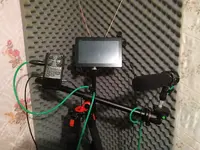I'm totally mystified by this topic - all the stuff about recording at specific knob settings and the technical stuff. We have a voice over recording problem. We really do not have to start soldering 150Ohm resistors and doing tests like this - which, I appreciate are necessary for really accurate comparisons in preamps - but here we are discussing fundamental beginners problems, and they're quite clear.
Please forgive me Anton - these comments are not meant to be derogatory or in any way personal - but you've picked up a few snippets of the subject but missed the critical ones. If you want to do good voice recordings, the important thing is the voice - NOT the microphone. They do make differences, but they are really small ones, and often very subtle and needing a really well trained pair of ears to assess properly. In your test recordings, you are very close to the microphone, speaking in a sub-whisper and in a fairly poor sounding room.
It was mentioned that mics don't discriminate - this is the real gem in the information. They capture sound - any sound in their sphere of capture. Voice over artists speak normally, or a little louder than usual conversation, but they treat the microphone as the audience - hence why lots of actors are rather good. They rarely get very close to the mic, unlike radio DJs - their voice is their distant voice. In the studio, closer miking is done for effect. It changes the voice, especially with a cardioid - it gets warmer, raspier, cosier - BUT - noisier. Sibilance, and gaps in the teeth become hurricanes and with better microphones or large diaphragm types, the sound becomes 'spotty' - so a decent pop shield is needed to control that. With reference to the room - the important thing is signal to noise, in this case - the speaker's volume compared to the noise and reflections from the walls. Speaking in a quiet voice needs more gain, and that brings up room sound, and if the room is untreated it sounds nasty.
You also failed to consider mic position. With certain artists it is necessary to mount the microphone out of the airstream - so from the side slightly, or from above looking down a little.
For people starting out - a zoom, or small condenser, or even the old trusty SM58 will produce good sound. For that kind of price it can be surprisingly decent. Buying a posh, expensive mic can produce in beginner hands far worse audio. They are so much less forgiving. I use through preference AKG 414 mics for lots of things - but they suck when put close in to a voice, unless you use some really good wind reduction. The Shure SM7B people bang on about is a great mic to have in close and bellow into and is really forgiving, but I don't like the sound. Neumann 87s are great for voice, but really need expert handling as small direction changes make big changes to the sound.
I cannot myself remember the last time I worried about levels - I'm sensitive to red lights - so I tend to under record, but we now have such a wide noise free recording dynamic range, I turn up till the meters have a fair way to go before getting to 0dB and that will do. I can add gain later, but it's really not a major concern. Same with preamps - I have quite a few ways to get mic audio into a computer and I'm sure there are performance differences - we often speak about them - but as they are all good for 99% of recording activities, I don't bother. If I need to record a sound effect of a squeeze door hinge at 10m away, then my mic choice would take a moment to think about and I'd probably use one particular interface (which is NOT my daily go to one).
What you need to do is speak up, move the mic to a few slightly further away positions while you listen on headphones and practice - not worry about the mics ........ yet. Sort the basics out and you will be out of the starting grid.
In your recording, you have a whistle - so that needs sorting and you mumble, and you can hear your breathing - so these are all easily sortable. On VO courses, it's often drummed into students that it is a performance, not a confidential. So imagine there is a person in front of you about six feet/2m away and you are having a conversation - start the mic at maybe 30cm/1ft first and give that a try. Mics are not magic, they're clinical. Your performance is everything.



